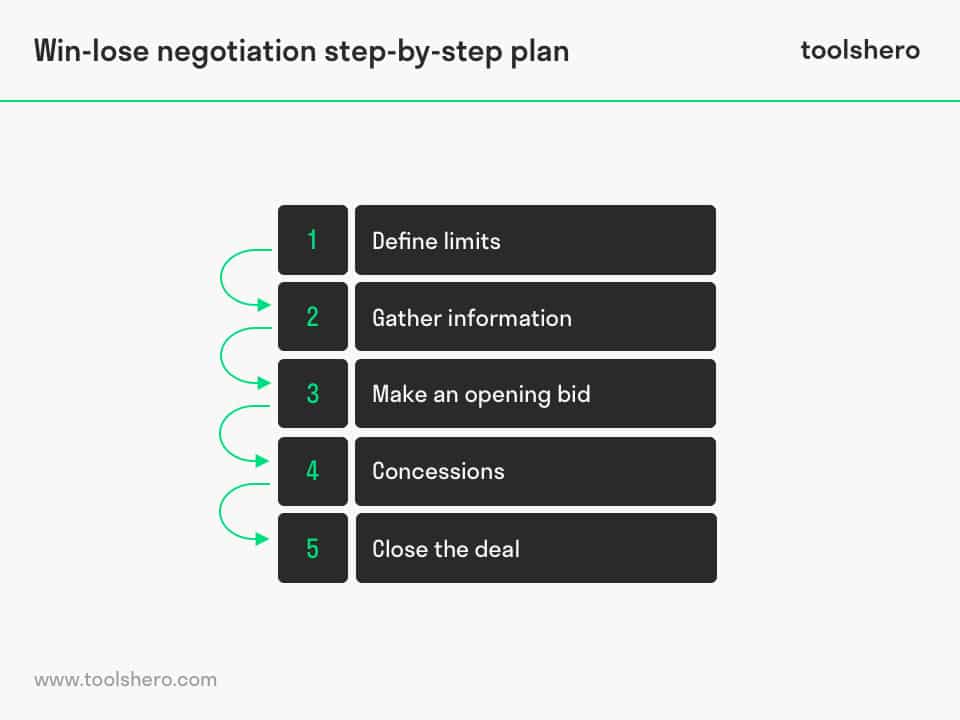Win Lose Negotiation explained

Win-lose Negotiation: this article provides a practical explanation of the Win-lose Negotiation. Next to the explanation of the definition, also distributive negotiations are being highlighted. This article also contains a step-by-step plan including an easy example and tips. Enjoy reading!
What is a Win-lose Negotiation? the defintion
Win-lose negotiation is a negotiation model for organisations where only one party experiences the outcome as positive.
In addition to the win-lose negotiation model, many other negotiation models have been created, including the win-win negotiation model and the RADPAC model.
Depending on the situation, different models are used. A simple example of a win-lose negotiation is a situation in which a certain quantity of resources must be distributed, resulting in a win-lose situation.
One party wins, whereas the other loses. Unless measures are taken, in a business environment this will often result in a permanently damaged relationship. Although the win-lose negotiation is not the most well-known form of negotiation, it is easily the most common.
With the win-lose negotiation model, individuals will often take on an impossible position in negotiations, such as placing too many demands on the other party, resulting in a bitter dispute.
In this situation, both parties will try to win without taking into account the outcome for the other. Both parties may have entered into negotiations with a desired goal and a certain point at which they will give up in mind.
Win Lose Negotiation: distributive negotiations
The win-lose negotiation model is used in negotiations where something is shared or exchanged. Distributive negotiations often feature a scenario in which two or more parties try to share or exchange a fixed number of resources.
Parties will enter negotiations with either the same or different interests. These negotiations will then end up with a winner and loser. The winner gets whatever he / she claimed or more, and the loser gets less or nothing.
The goal is therefore for one party to win as much as possible. Distributive negotiations or the win-lose negotiation models are also widely used in daily life, especially when selling products that do not have a fixed price.
In the Western world, this is often limited to a local market, but in New Delhi for example a large number of products has no fixed priced, allowing plenty of room for negotiation.
Unlike distributive negotiations, integrative negotiations focus on creating profit for all parties and ‘expanding the pie’. Basically, this approach to negotiation is more like the win-win negotiation model.
Win-lose negotiation step-by-step plan + example
Distributive negotiations often take place when limited resources are available. Common situations in which this approach is used include the purchase of a house, a second-hand car, or when asking for a raise.
Negotiation skills can be acquired. Many people have intuitive negotiation strategies, and others are good at learning and implementing effective negotiation techniques. Later in this article, we will focus on the various character traits that are desired in situations in which the win-lose negotiation model is used.
However, we will first address the various steps within a win-lose negotiation. Each of the steps will be explained in detail.

The Five Steps of a Win-Lose Negotiation Tactic.
1. Define limits regarding the win-lose negotiation situation
Every party in a negotiating situation must clearly define what he or she wants to leave the negotiating table with. The desired outcome must therefore be closely monitored during the actual negotiations. Points of resistance are those areas in which a party absolutely cannot continue negotiations.
An example is an employee who asks for a raise during an assessment interview. The employee in question has decided his new minimum salary in advance.
2. Gather information
Prior to a negotiation, it is wise to obtain information about its purpose and the other party’s points of resistance. As long as the information is reliable, it doesn’t matter whether this information is obtained directly or indirectly. In the model of win-lose negotiation, this information is used as negotiating power.
For example, the employee negotiating his new salary can use information about his productivity or important results to strengthen his position.
3. Make an opening bid
The third step in the win-lose negotiation is making a bid or demand. Commencing this step will set the tone for the rest of the negotiations. The attitude with which the opening bid is made is very important. If the party enjoys a strong competitive position, he can make an excessive opening bid.
The employee knows his worth, and has an amount in mind that he confidently shares with his manager during the interview. In the example of salary negotiations, however, it is not customary to make an excessive opening bid.
4. Concessions
As soon the various bids have been made, parties will start to negotiate. Characteristic of the win-lose negotiation model is that one party wins and the other loses.
In practice, this means that one party makes an excessive opening bid, and is subsequently unable to counter the other.
The employee shares his vision and the amount to which he believes he is entitled. The employer may then accept or reject this. At the same time, a happy medium may also be found.
5. Close the deal
There are various tactics for closing a deal. One example is the ‘assume-the-close’ method. In this method, one party pretends that the deal has already been closed, even though this is not yet the case. This is done in the hope that the other party agrees and will stop negotiating.
In addition, a last ‘surprise’ may also be used as bait for closing a deal. This tactic is often used in the win-lose negotiation model. Whereas one party may seem satisfied with the offer, the deal will later turn out to be disappointing.
Character traits for effective negotiation
A skilled negotiator has a number of character traits. In sales and retail in particular, major steps are taken to ensure the effectiveness of negotiation.
Understand the negotiation process
Effective negotiators recognise that negotiating can be a complex process, and it’s not just a matter of discussing and sharing conditions. It requires a certain understanding of the dynamics that influence the process. Learning to negotiate well is possible by practising, evaluating, and improving various techniques and strategies.
Win-lose negotiation? Focus on winning
A Win-lose negotiation means that one party aims to win as much as possible. Because a win-win negotiation is often more desirable, very few books have been written on win-loss strategies. The essence of this style is that one party yields as little as possible.
Patience
Patience is a quality that is actually more suited to win-win models of negotiation. Although in a win-lose negotiation people will look to quickly close the deal with as much benefit as possible, patience and tact are often more effective in other negotiation situations.
In the latter situations, negotiators will not rush to reach an agreement. Instead, they will take their time to evaluate different options. After all, the goal is for both parties to benefit.
The American Massachusetts Institute of Technology also describes several qualities that every good negotiator should possess:
- Planning skills
- Knowledge about the subject
- Ability to think quickly and clearly under pressure and uncertainty
- Ability to effectively communicate thoughts verbally
- Listening skills
- Persuasiveness
- Decisiveness
- Awareness about the other party
Now It’s Your turn
What do you think? Are you familiar with the explanation of win-lose negotiation style? What is your favourite model for negotiations? What do you think are important aspects to look out for during negotiations? Do you have any tips or additional comments?
Share your experience and knowledge in the comments box below.
More information
- Calero, H. H. (1979). Winning the negotiation. Hawthorn Books.
- Fang, T. (2006). Negotiation: the Chinese style. Journal of Business & Industrial Marketing, 21(1), 50-60.
- Gruenbacher, P. (2000, September). Collaborative requirements negotiation with EasyWinWin. In Proceedings 11th International Workshop on Database and Expert Systems Applications (pp. 954-958). IEEE.
How to cite this article:
Janse, B. (2019). Win Lose Negotiation. Retrieved [insert date] from Toolshero: https://www.toolshero.com/management/win-lose-negotiation/
Original publication date: 06/07/2019 | Last update: 11/17/2023
Add a link to this page on your website:
<a href=”https://www.toolshero.com/management/win-lose-negotiation/”>Toolshero: Win Lose Negotiation</a>










